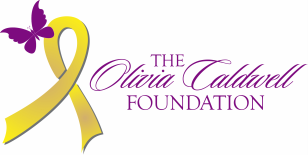The Olivia Caldwell Foundation (OCF) and its major role in the evolution of therapy for children with low grade gliomas

Written By: Dr. Nicholas Foreman, Lead Researcher, Children's Hospital Colorado Neurooncology Department, Nov 2020
HISTORY OF LOW GRADE GLIOMAS
Low grade gliomas of the brain are the most common pediatric brain tumor. They can occur anywhere in the brain and are driven by multiple different genetic factors that cause either damage to a gene or the fusion of two genes together that should be separated.
Until relatively recently, the only therapies for these tumors were surgery, radiation, and chemotherapy. These therapies were often effective for the most common types of low-grade gliomas, but they came at a price with a variety of debilitating side effects. Surgery in one specific area of the brain (the cerebellum) for one specific type of low-grade glioma (Braf fusion positive) results in a cure in almost all cases. In other locations, where the tumor is deeper or extends across different parts of the brain, surgery rarely results in a cure and was often associated with devastating long-term injury. Radiation was only sparingly used for low-grade gliomas of childhood because of its adverse impact on the developing brains of the young children suffering from these tumors.
Chemotherapy was commonly used for 30 years, with very little progress or change in the drugs used. The chemotherapy used had to be given almost every week into a vein, often involved travel over long distances, and was disruptive to family life and schooling. Although there was a high rate of shrinkage of tumors, it was still common for tumors to come back after therapy ended. Some children would go from relapse to relapse until they reached adulthood when their tumors would often stop growing, but they were left with physical and mental scars. Moreover, certain low-grade gliomas, driven by "bad genetic drivers" (such as those seen in children with FGFR mutations and fusions) only responded for a time to chemotherapy and when the tumor returned, almost all children would die.
CHANGING OUTCOMES BY IDENTIFYING GENETIC DRIVERS BEHIND TUMOR GROWTH
The first question then for the brain tumor doctors in Colorado to answer was whether very specific drugs targeting only cells with specific genetic drivers could be developed. This was more complex than it sounds because, as it turned out, there were multiple genetic drivers of low-grade gliomas, and even when the same gene was damaged, if the type of damage was different, then a different therapy was needed. Fortunately, the group at CHCO had been collecting samples from children with low-grade gliomas for many years. The Olivia Caldwell Foundation supplied monies to develop tests to rapidly look for these genetic drivers. Haste was of the essence so that, in newly diagnosed children, their drivers could be rapidly identified and an appropriate targeted agent could hopefully be identified. Then dozens of samples were tested for these genetic drivers using the new techniques.
Multiple new drivers were identified. Moreover, the outcomes of all the children whose samples were used were known. It turned out that certain mutations/fusions were associated with very poor outcomes when treated with standard chemotherapy, including the FGFR driver that Olivia had. It also became apparent that specific drivers had to be identified very precisely even if in the same gene. A therapy that would treat a mutation in the Braf gene had the potential to make a tumor grow if the Braf gene fused with another gene. This new knowledge spurred the development of therapeutic agents to target these mutation/fusion drivers. These new agents were tested in our labs using cell lines with the different drivers to look at efficacy, again with OCF-raised monies. They were gradually introduced into the clinic.
A REVOLUTION IN TREATMENT IS FOUND
The result was revolutionary. This was true even for many of those children whose tumors had been responsive to chemotherapy, for now they could be treated with a pill instead of weekly chemotherapy injections. The impact of this for the children in our wide catchment region (we treat children with brain tumors from New Mexico to Montana at CHCO) was profound! Moreover, children who would normally experience the toxic effects of chemotherapy that could be even more severe among certain groups (such as those with neurofibromatosis) were spared often debilitating neurological side effects. Children with low-grade gliomas that had been aggressive and poorly responsive to chemotherapy) such as those with FGFR1 mutations/fusions) could be successfully treated with the new targeted agents. Furthermore, it turned out that certain mutation/fusion drivers were discovered to also be involved with immediately life-threatening high-grade gliomas and that these new targeted therapies offered a chance for a cure for the first time. For example, a child from Montana with an NF1 mutated driver and a high-grade glioma (the deadly glioblastoma) who would have lived only 4-6 months with radiation and very strong, unpleasant chemotherapy (that could only be delivered in Denver) is alive more than a year later with a combination of radiation and a targeted therapy in the form of a pill.
MORE WORK TO BE DONE
There are still issues, however. This is a revolution that is not over and OCF money continues to fund advances in this area. We have discovered recently that certain mutations/drivers are best attacked at two points, not one. The attack is directly on the specific driver but also on genes that have wrongly gone "down-stream" of that gene. Essentially, two pills can be better than one, resulting in more effective therapy and reducing the risk of the cancer returning. This is still being worked on. Moreover (and rather strangely) when two pills are used, the side-effects are often less. For example, both medications used for one type of Braf mutational driver can cause severe skin rashes when used alone, but when both are used in conjunction, skin rashes are rare. Even where targeted agents are effective, we continue to look and test alternative agents that may have fewer side effects.
OVERCOMING DEADLY RESISTANCE TO TARGETED AGENTS
A big area that we are currently working on is the issue of resistance to targeted agents. Although not common, this is potentially devastating and can be life threatening. We have already started looking to see if this is in part caused by the lack of a body's reaction to the tumor that enables the tumor to escape the targeted therapy. In an earlier study (funded by OCF) we found certain low-grade gliomas were "cold," with poor immune reactions to them. We continued to explore this in the lab and have recently had remarkable successes in the first children treated whose tumors had grown in spite of targeted therapy by adding an immune agent. Some of these children had failed conventional therapy, standard chemotherapy, and then targeted therapy, but had a dramatic response to combined targeted therapy and immunotherapy. It is also possible that resistance can arise from a second new mutation/fusion driver added to the initial one. We are studying this by examining thousands of single cells in any one low grade glioma using a technique that allows us to look at the entire genetic makeup in a single cell to see if that cell has more than one mutation/fusion. This would help us predict whether an individual might grow cells with two mutations/fusions as a way of resisting targeted therapy.
A NEW WAY TO DIAGNOSE BRAIN TUMORS
The traditional way of discovering what mutation/fusion is driving a low-grade glioma is by taking a biopsy of the tumor with neurosurgery. This in itself is potentially hazardous. We have shown recently in just an initial handful of children that we can find the driving genetic mutation in the fluid that surrounds the brain, which can be obtained safely. This is because tumors are leaky and shed material including (potentially) the drivers of all brain tumors. It is possible that, by making the technique more sensitive, we could also detect these drivers in blood. This is one of many examples of ground-breaking, burgeoning research that is constantly in need of financial support.
ASPIRATIONS GOING FORWARD
Ultimately, we aspire to diagnose pediatric low grade gliomas by a blood test alone; to administer oral therapy by giving two pills with minimal side effects; to conduct scans locally and improve the quality of scans with rapid electronic transfer of images to CHCO; to employ advanced genetics including single-cell testing and immunological studies for any (hopefully rare) tumor recurrences; to conduct follow-up visits between patient and neuro-oncologist largely by telehealth to further reduce life disruption among these families; and to achieve excellent outcomes, including improved quality of life, for all children.
These are the goals of the Olivia Caldwell Foundation as well as of the neuro-oncologists whose work they fund.
Low grade gliomas of the brain are the most common pediatric brain tumor. They can occur anywhere in the brain and are driven by multiple different genetic factors that cause either damage to a gene or the fusion of two genes together that should be separated.
Until relatively recently, the only therapies for these tumors were surgery, radiation, and chemotherapy. These therapies were often effective for the most common types of low-grade gliomas, but they came at a price with a variety of debilitating side effects. Surgery in one specific area of the brain (the cerebellum) for one specific type of low-grade glioma (Braf fusion positive) results in a cure in almost all cases. In other locations, where the tumor is deeper or extends across different parts of the brain, surgery rarely results in a cure and was often associated with devastating long-term injury. Radiation was only sparingly used for low-grade gliomas of childhood because of its adverse impact on the developing brains of the young children suffering from these tumors.
Chemotherapy was commonly used for 30 years, with very little progress or change in the drugs used. The chemotherapy used had to be given almost every week into a vein, often involved travel over long distances, and was disruptive to family life and schooling. Although there was a high rate of shrinkage of tumors, it was still common for tumors to come back after therapy ended. Some children would go from relapse to relapse until they reached adulthood when their tumors would often stop growing, but they were left with physical and mental scars. Moreover, certain low-grade gliomas, driven by "bad genetic drivers" (such as those seen in children with FGFR mutations and fusions) only responded for a time to chemotherapy and when the tumor returned, almost all children would die.
CHANGING OUTCOMES BY IDENTIFYING GENETIC DRIVERS BEHIND TUMOR GROWTH
The first question then for the brain tumor doctors in Colorado to answer was whether very specific drugs targeting only cells with specific genetic drivers could be developed. This was more complex than it sounds because, as it turned out, there were multiple genetic drivers of low-grade gliomas, and even when the same gene was damaged, if the type of damage was different, then a different therapy was needed. Fortunately, the group at CHCO had been collecting samples from children with low-grade gliomas for many years. The Olivia Caldwell Foundation supplied monies to develop tests to rapidly look for these genetic drivers. Haste was of the essence so that, in newly diagnosed children, their drivers could be rapidly identified and an appropriate targeted agent could hopefully be identified. Then dozens of samples were tested for these genetic drivers using the new techniques.
Multiple new drivers were identified. Moreover, the outcomes of all the children whose samples were used were known. It turned out that certain mutations/fusions were associated with very poor outcomes when treated with standard chemotherapy, including the FGFR driver that Olivia had. It also became apparent that specific drivers had to be identified very precisely even if in the same gene. A therapy that would treat a mutation in the Braf gene had the potential to make a tumor grow if the Braf gene fused with another gene. This new knowledge spurred the development of therapeutic agents to target these mutation/fusion drivers. These new agents were tested in our labs using cell lines with the different drivers to look at efficacy, again with OCF-raised monies. They were gradually introduced into the clinic.
A REVOLUTION IN TREATMENT IS FOUND
The result was revolutionary. This was true even for many of those children whose tumors had been responsive to chemotherapy, for now they could be treated with a pill instead of weekly chemotherapy injections. The impact of this for the children in our wide catchment region (we treat children with brain tumors from New Mexico to Montana at CHCO) was profound! Moreover, children who would normally experience the toxic effects of chemotherapy that could be even more severe among certain groups (such as those with neurofibromatosis) were spared often debilitating neurological side effects. Children with low-grade gliomas that had been aggressive and poorly responsive to chemotherapy) such as those with FGFR1 mutations/fusions) could be successfully treated with the new targeted agents. Furthermore, it turned out that certain mutation/fusion drivers were discovered to also be involved with immediately life-threatening high-grade gliomas and that these new targeted therapies offered a chance for a cure for the first time. For example, a child from Montana with an NF1 mutated driver and a high-grade glioma (the deadly glioblastoma) who would have lived only 4-6 months with radiation and very strong, unpleasant chemotherapy (that could only be delivered in Denver) is alive more than a year later with a combination of radiation and a targeted therapy in the form of a pill.
MORE WORK TO BE DONE
There are still issues, however. This is a revolution that is not over and OCF money continues to fund advances in this area. We have discovered recently that certain mutations/drivers are best attacked at two points, not one. The attack is directly on the specific driver but also on genes that have wrongly gone "down-stream" of that gene. Essentially, two pills can be better than one, resulting in more effective therapy and reducing the risk of the cancer returning. This is still being worked on. Moreover (and rather strangely) when two pills are used, the side-effects are often less. For example, both medications used for one type of Braf mutational driver can cause severe skin rashes when used alone, but when both are used in conjunction, skin rashes are rare. Even where targeted agents are effective, we continue to look and test alternative agents that may have fewer side effects.
OVERCOMING DEADLY RESISTANCE TO TARGETED AGENTS
A big area that we are currently working on is the issue of resistance to targeted agents. Although not common, this is potentially devastating and can be life threatening. We have already started looking to see if this is in part caused by the lack of a body's reaction to the tumor that enables the tumor to escape the targeted therapy. In an earlier study (funded by OCF) we found certain low-grade gliomas were "cold," with poor immune reactions to them. We continued to explore this in the lab and have recently had remarkable successes in the first children treated whose tumors had grown in spite of targeted therapy by adding an immune agent. Some of these children had failed conventional therapy, standard chemotherapy, and then targeted therapy, but had a dramatic response to combined targeted therapy and immunotherapy. It is also possible that resistance can arise from a second new mutation/fusion driver added to the initial one. We are studying this by examining thousands of single cells in any one low grade glioma using a technique that allows us to look at the entire genetic makeup in a single cell to see if that cell has more than one mutation/fusion. This would help us predict whether an individual might grow cells with two mutations/fusions as a way of resisting targeted therapy.
A NEW WAY TO DIAGNOSE BRAIN TUMORS
The traditional way of discovering what mutation/fusion is driving a low-grade glioma is by taking a biopsy of the tumor with neurosurgery. This in itself is potentially hazardous. We have shown recently in just an initial handful of children that we can find the driving genetic mutation in the fluid that surrounds the brain, which can be obtained safely. This is because tumors are leaky and shed material including (potentially) the drivers of all brain tumors. It is possible that, by making the technique more sensitive, we could also detect these drivers in blood. This is one of many examples of ground-breaking, burgeoning research that is constantly in need of financial support.
ASPIRATIONS GOING FORWARD
Ultimately, we aspire to diagnose pediatric low grade gliomas by a blood test alone; to administer oral therapy by giving two pills with minimal side effects; to conduct scans locally and improve the quality of scans with rapid electronic transfer of images to CHCO; to employ advanced genetics including single-cell testing and immunological studies for any (hopefully rare) tumor recurrences; to conduct follow-up visits between patient and neuro-oncologist largely by telehealth to further reduce life disruption among these families; and to achieve excellent outcomes, including improved quality of life, for all children.
These are the goals of the Olivia Caldwell Foundation as well as of the neuro-oncologists whose work they fund.




